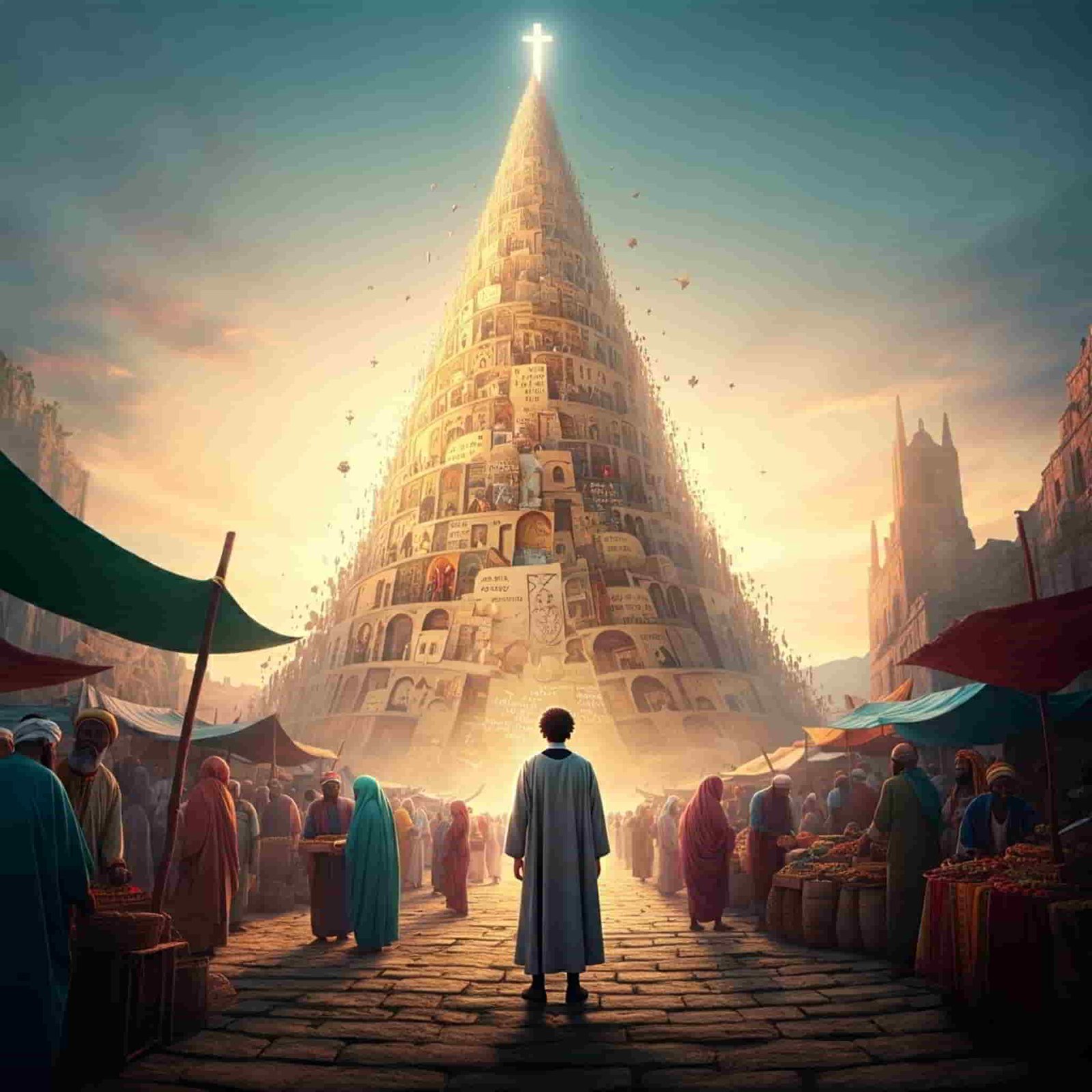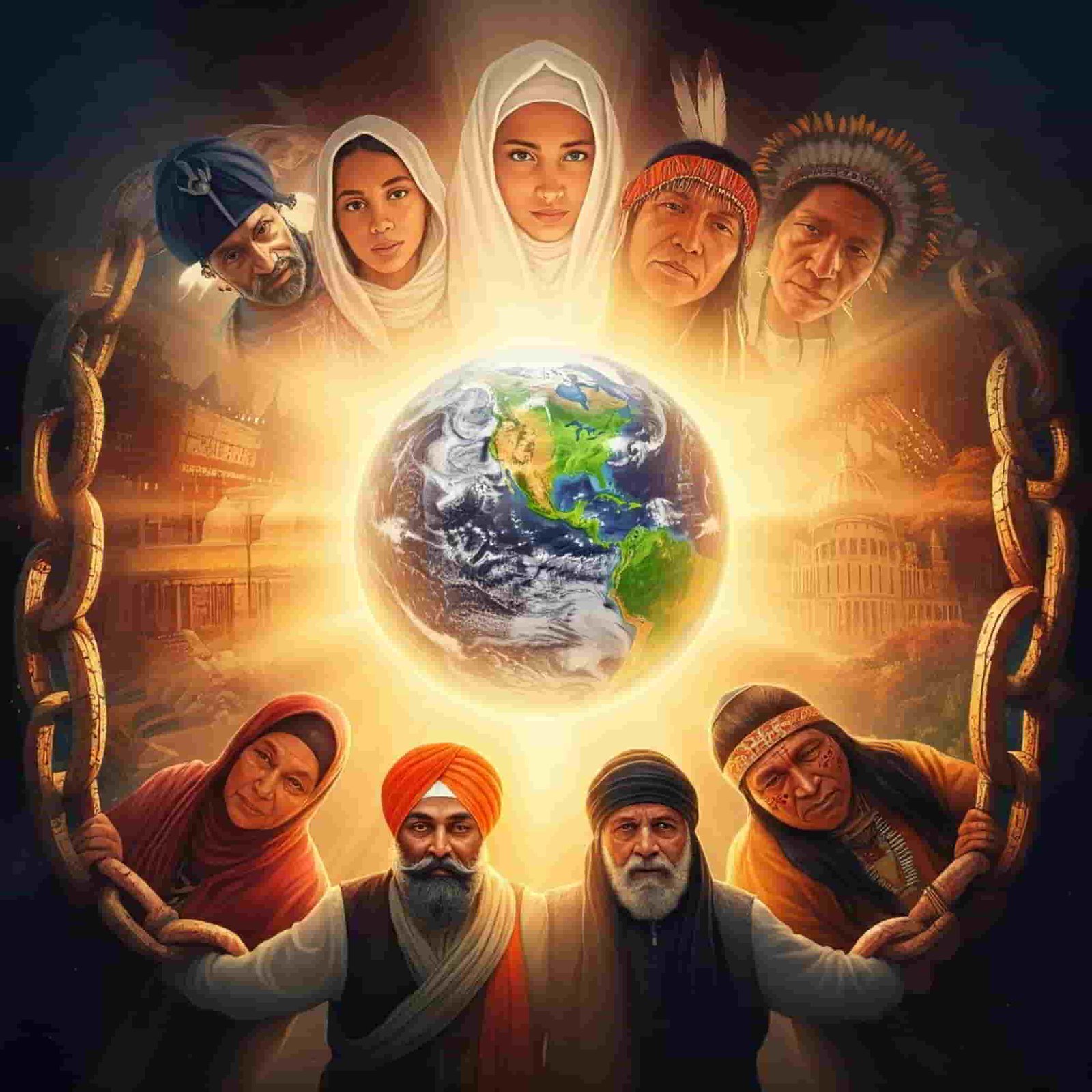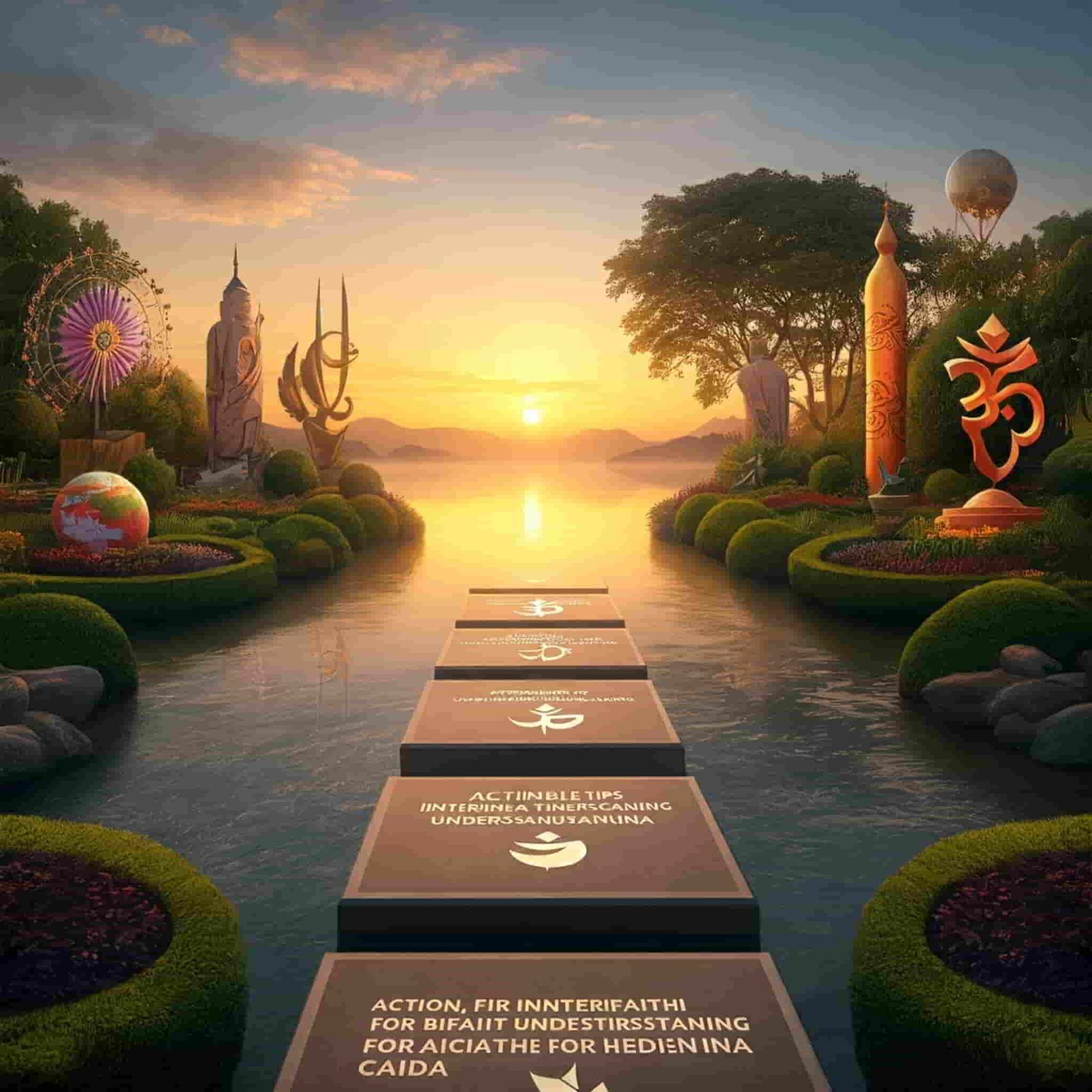TL;DR: The Universal Language of Faith: Bridging Humanity and the Divine
- Faith, like language, is a universal way to communicate and connect with the divine, transcending cultural and linguistic boundaries.
- Diverse religious traditions, like languages, offer unique expressions and paths to spiritual fulfillment and the human desire to find meaning and purpose.
- Embrace the diversity of faith expressions and engage in respectful dialogue to foster mutual understanding and a more harmonious, interconnected world.
At-a-glance:
Faith is a universal language in our increasingly interconnected world, offering a compelling perspective on how humans connect with the divine or transcendent.
This blog post explores the rich tapestry of religious traditions, drawing parallels between the multitude of spoken languages and the various expressions of faith.
We’ll delve into the shared themes across religions, the importance of respecting diverse beliefs, and the potential for interfaith dialogue to foster greater understanding and harmony in our global society.
Just as languages vary globally, so do religious expressions, each with its unique history, cultural context, and theological perspectives, forming diverse paths that bridge humanity and the divine.
The Babel of Belief: A Personal Journey Through Faith
As a young theologian, I stood at the base of a metaphorical Tower of Babel, surrounded by religious voices.
Each tradition seemed to speak its unique language of faith, and I wondered how anyone could make sense of this divine diversity.

A theologian’s awakening to the diverse languages of faith at the Tower of Babel. © Copyright WisdomBread™
Growing up in a multi-religious community in India, I was always fascinated by how people expressed their faith.
From the vibrant rituals of Hinduism, with its colorful festivals and intricate temple carvings, to the meditative practices of Buddhism, each tradition offered a unique perspective.
Monks in saffron robes sought enlightenment in quiet contemplation, providing a window into the human longing for meaning and connection.
I remember attending a Ganesh Chaturthi, Durga Pooja, Diwali, Shivratri, Saraswati Pooja, and Kali Pooja celebration with my Hindu friends, mesmerized by the elaborate processions and the sincere devotion of the worshippers.
The air was thick with incense, and the rhythmic chanting of mantras created an atmosphere of both joy and reverence.
Later that week, I would find myself in a Buddhist monastery, observing the serene faces of monks as they meditated, their breaths slow and steady, their minds focused on achieving inner peace.
My turning point came during a visit to a bustling marketplace in Jerusalem. There, I witnessed Jewish merchants, Muslim shopkeepers, and Christian pilgrims dancing in commerce and conversation.

A theologian’s awakening to the diverse languages of faith at the Tower of Babel. © Copyright WisdomBread™
Despite their different religious backgrounds, they communicated effortlessly, finding common ground in their shared humanity. It struck me then that faith, like language, is a tool for connection – not division.
This realization set me on a path to understanding the universal language of faith and how it bridges the gap between humanity and the divine across various religious traditions.
Decoding the Divine: The Shared Syntax of Spirituality
As I delved deeper into my studies, I discovered that religions, much like languages, share common elements that form a kind of spiritual syntax. Just as languages have nouns, verbs, and adjectives, religions often include:
- Sacred texts: The Bible, Quran, Bhagavad Gita, and other holy scriptures serve as the foundational “vocabulary” of faith.
- Rituals and practices: Prayer, meditation, and worship are the “grammar” that structures religious expression.
- Ethical guidelines: Moral codes and commandments are the “syntax” that guides believers’ actions.
- Symbols and imagery: Religious symbols act as a visual “alphabet” that conveys complex spiritual concepts.
Understanding these shared elements helped me see that while the “words” might differ, the underlying structure of faith often remains remarkably similar across traditions.

A tapestry of faith emerges from sacred texts, revealing the universal language of spirituality. © Copyright WisdomBread™
Symbols and rituals play a crucial role in the language of faith. They act as visual cues, triggering deep-seated emotions and connecting individuals to a shared history and tradition.
The cross in Christianity, the Star of David in Judaism, and the crescent moon in Islam carry profound meaning for believers, representing core values and beliefs.
Similarly, baptism, prayer, and pilgrimage reinforce faith and create a sense of community.
The Rosetta Stone of Religion: Finding Common Ground
Just as the Rosetta Stone provided a key to deciphering ancient Egyptian hieroglyphs, I discovered that specific universal themes serve as spiritual Rosetta Stone, helping us understand and appreciate diverse religious traditions. These common themes include:
- The search for meaning: Humans seek to understand their purpose and place in the universe across religions.
- Connection with the transcendent: Through prayer, meditation, or ritual, believers aim to connect with something greater than themselves.
- Ethical living: Most religions provide guidelines for moral behavior and social responsibility.
- Community and belonging: Faith often fosters community and shared identity among believers.
- Transformation and growth: Many traditions emphasize personal and spiritual development as a central aspect of religious life.
Recognizing these shared themes allowed me to appreciate the unity underlying the apparent diversity of religious expression.

A tapestry of faith emerges from sacred texts, revealing the universal language of spirituality. © Copyright WisdomBread™
Faith offers stability and purpose in a world of uncertainty and change. It provides answers to life’s big questions –
Why are we here?
What is our purpose?
What happens after we die?
– offering comfort and hope in the face of life’s challenges.
Whether it’s the belief in reincarnation in Hinduism and Buddhism, the concept of heaven and hell in Christianity and Islam, or the ancestral spirits revered in many indigenous traditions, faith provides a framework for understanding the mysteries of life and death.
The Tower of Babel Reimagined: Embracing Religious Diversity
As I continued my journey, I began to see the story of the Tower of Babel in a new light.
Rather than a curse of confusion, the diversity of religious “languages” could be viewed as a blessing – an opportunity for humanity to explore the divine through myriad perspectives.

A world united through faith: diverse religious traditions come together in harmony. © Copyright WisdomBread™
This realization led me to propose a new approach to interfaith dialogue, one that:
- Celebrates diversity: Recognizes the unique value of each religious tradition.
- Promotes understanding: Encourages learning about different faiths without judgment.
- Seeks common ground: Identifies shared values and goals across traditions.
- Fosters collaboration: Encourages interfaith cooperation on social and ethical issues.
- Respect boundaries: Acknowledges the right of individuals to choose their path.
By embracing this approach, we can transform the Tower of Babel from a symbol of division into a monument to human spiritual creativity and diversity.
The Polyglots of Faith: Navigating Multiple Religious Languages
In our increasingly globalized world, many individuals navigate multiple religious traditions through personal exploration or interfaith families and communities.
These spiritual polyglots offer valuable insights into the interconnectedness of religious languages.
For example, consider the story of Sarah, a woman raised in a Jewish-Christian interfaith family who later married a Muslim man.
Sarah’s experience celebrating Hanukkah, Christmas, and Ramadan within a single household exemplifies the potential for harmonious coexistence among diverse faith traditions. Such experiences highlight the importance of:
- Religious literacy: Understanding the basics of various faith traditions.
- Cultural sensitivity: Respecting diverse religious practices and beliefs.
- Open-mindedness: Being willing to learn from different spiritual perspectives.
- Flexibility: Adapting to various religious contexts and environments.
- Bridge-building: Facilitating understanding between different faith communities.
By cultivating these skills, we can become more adept at “speaking” multiple religious languages and fostering interfaith harmony.
The Universal Translator: Love and Compassion as Spiritual Esperanto
Throughout my studies and personal experiences, I’ve come to believe that love and compassion serve as universal translators of faith.
Kindness and empathy are universally understood and appreciated regardless of the specific religious language spoken. This idea is reflected in many religious teachings:
- Christianity: “Love your neighbor as yourself” (Mark 12:31)
- Islam: “None of you [truly] believes until he wishes for his brother what he wishes for himself” (An-Nawawi’s Forty Hadith 13)
- Buddhism: “May all beings be happy and free, and may the thoughts, words, and actions of my own life contribute in some way to that happiness and to that freedom for all” (Metta Bhavana)
- Hinduism: “This is the sum of duty: do not do to others what would cause pain if done to you” (Mahabharata 5:1517)
By focusing on these universal principles of love and compassion, we can transcend the barriers of specific religious languages and connect on a deeper, more fundamental level.
The Power of Faith in the Modern World
Research has shown that faith can profoundly impact individuals and communities. Studies have linked religious involvement to various benefits, including:
- Improved mental health: Faith can provide a sense of purpose, meaning, and belonging, which can help reduce stress, anxiety, and depression.
- Increased social support: Religious communities offer opportunities for social interaction and support, which can foster a sense of belonging and connection.
- Enhanced physical health: Some studies suggest that religious involvement may be associated with better physical health outcomes, such as lower blood pressure and reduced mortality risk.
Faith can also foster resilience in the face of adversity. By providing a sense of hope and a belief in a higher power, faith can help individuals overcome challenges and cope with difficult situations.
Consider the story of Viktor Frankl, a psychiatrist who survived the horrors of the Holocaust. He attributed his survival to finding meaning and purpose even amid unimaginable suffering.
He said that his faith provided him with the inner strength to endure.
In today’s rapidly changing world, faith is vital in providing individuals and communities with a sense of grounding and direction.
While secularism and materialism are rising worldwide, faith offers a powerful counter-narrative, reminding us of the importance of spiritual values and the search for meaning beyond the material realm.
The rise of technology has also impacted how people experience and express their faith. Social media platforms and online communities have created new spaces for religious expression and interfaith dialogue.
Virtual religious services, online prayer groups, and digital scripture study groups have made it easier for people to connect with their faith and others who share their beliefs, regardless of geographical boundaries.
As we continue to navigate the complex landscape of faith in the 21st century, understanding Religion as a universal language offers a robust framework for promoting interfaith harmony and mutual understanding.
By recognizing the shared elements across diverse traditions, celebrating the richness of religious expression, and focusing on the universal principles of love and compassion, we can build bridges between different faith communities and foster a more inclusive and peaceful world.
Actionable Tips: Bridging Faith Divides and Deepening Your Spiritual Journey
1. Embark on a faith exploration journey: Choose a Religion you’re unfamiliar with and commit to reading one book or attending one lecture about it this month. For a comprehensive overview, start with “The World’s Religions” by Huston Smith.
2. Practice the art of sacred listening: The next time you engage with someone of a different faith, challenge yourself to listen without interrupting for at least five minutes. Then, reflect on what you’ve learned.
3. Immerse yourself in interfaith experiences: Find and attend an event in your community within the next two weeks. If none are available, organize a small gathering with friends from different faith backgrounds.
4. Conduct a personal faith audit: Set aside 30 minutes this week to write down the core elements of your own beliefs. Identify which aspects might be universal across different faiths.
5. Craft your spiritual narrative: Write a 500-word story about your faith journey. Please share it with a trusted friend from a different religious background and invite their perspective.
6. Develop your empathy muscles: Choose a religious practice different from your own (e.g., fasting during Ramadan) and try it for a day. Write a journal about your experience and insights.
7. Become a religious freedom advocate: Research local religious discrimination issues and write a letter to your representative advocating for religious freedom. Do this within the next month.
8. Create a personal symbol dictionary: Over the next week, learn about and sketch five religious symbols from different faiths. Reflect on their meanings and how they relate to your own beliefs.

A path to interfaith harmony: actionable steps leading to a garden of religious understanding. © Copyright WisdomBread™
9. Implement a daily mindfulness practice: Start with just 5 minutes a day of quiet reflection on your own biases and preconceptions about other religions. Use an app like Headspace to guide you.
10. Build interfaith bridges: Identify three values you share with a different faith tradition. Contact a local religious leader or community member of that faith to discuss these shared values over coffee.
11. Cultivate a daily spiritual practice: Begin each morning with a few minutes of mindful meditation, find a quiet space for prayer and reflection, or volunteer at a local charity to connect with your community and make a difference.
12. Unlock deeper self-awareness: This week, write a journal about the values and principles that guide your life. Reflect on what gives you a sense of purpose and how your faith influences your decisions and interactions with others.
13. Embrace continuous learning: Challenge your assumptions, seek out diverse perspectives, and engage in open-minded discussions about faith and spirituality.
14. Join a faith community: Visit different places of worship in your area and find one where you feel a sense of belonging. Participate in religious services, join a study group, or attend social events to connect with others who share your beliefs.
15. Immerse yourself in sacred texts: Set aside time each week to read and reflect on passages from religious texts that resonate with you, such as the Bible, Quran, Torah, or Bhagavad Gita.
16. Practice mindfulness throughout your day: Take moments to pause, breathe deeply, and focus on the present moment. Savor your food, appreciate nature, and express gratitude for life’s blessings.
17. Engage in service: Dedicate your time and talents to a cause you believe in. Volunteer at a local soup kitchen, mentor a young person or donate to a charity that aligns with your values.
Remember, the journey of interfaith understanding and personal spiritual growth starts with a single step.
Please choose one of these tips to implement today and share your experience with us in the comments below!
Final Thoughts: Embracing the Universal Language of Faith
As we navigate the complex landscape of faith in our interconnected 21st-century world, understanding Religion as a universal language offers a robust framework for promoting interfaith harmony and mutual understanding.
By recognizing the shared elements across diverse traditions, celebrating the richness of religious expression, and focusing on the universal principles of love and compassion, we can build bridges between different faith communities and foster a more inclusive and peaceful world.
The tapestry of faith, woven from the threads of diverse religious traditions, is a testament to humanity’s quest for meaning and connection with the divine.
As we learn to appreciate and respect the many languages of faith, we open ourselves to a deeper understanding of our shared humanity and the transcendent realities that unite us all.
Imagine a world where people of different faiths unite, not in conflict, but in celebration of their shared humanity. A world where mosques, churches, synagogues, temples, and other places of worship stand side-by-side, not as symbols of division, but as beacons of hope and understanding.
We can strive for this vision – a world where the universal language of faith unites us in our quest for meaning, purpose, and connection with the divine.
Remember, embracing this universal language of faith is not just an intellectual exercise—it’s a transformative journey that can enrich our lives and communities.

A path to interfaith harmony: actionable steps leading to a garden of religious understanding. © Copyright WisdomBread™
You can start making a real difference today by implementing the actionable tips in this blog post.
Whether learning about a new faith tradition, practicing active listening, or participating in interfaith events, each step you take brings us closer to a world of greater understanding and harmony.
Don’t miss the opportunity to be part of this powerful movement towards interfaith understanding.
The time to act is now.
Engaging with diverse faith traditions expands our spiritual horizons and contributes to a more tolerant and compassionate global society.
Take the first step today.
Please choose one of the actionable tips from this post and commit to implementing it this week. Share your experiences with friends and family, and encourage them to join you on this journey of discovery and connection.
Remember, every conversation, every act of empathy, and every moment of shared understanding brings us closer to realizing the true potential of our diverse yet interconnected world of faith.
Together, we can weave a tapestry of faith that celebrates our differences while highlighting our shared humanity.
Let’s embrace the universal language of faith and create a world where diverse spiritual paths lead to a common ground of mutual respect, understanding, and peace.
Always Remember:
Faith is a universal language that unites us in our shared humanity.
Embracing diverse faith traditions enriches our understanding of humanity and the divine.
Start your interfaith journey today to foster a more harmonious world.
FAQs:
Q1: How can I respectfully learn about other religions without appropriating their practices?
A: To respectfully learn about other religions, start by reading reputable sources and academic texts about the faith traditions you’re interested in.
Attend public lectures or events hosted by religious communities, but always be mindful of your role as an observer.
If you’re invited to participate in rituals or practices, ask about the appropriate level of involvement for non-adherents.
Remember to approach your learning with humility and an open mind, and avoid adopting sacred practices or symbols without proper understanding and context.
Q2: What are some common misconceptions about interfaith dialogue?
A: Some common misconceptions about interfaith dialogue include:
- It requires compromising one’s own beliefs.
- The goal is to create a single, unified Religion.
- It’s only for religious leaders or scholars.
- It’s not relevant in secular societies.
- It always leads to agreement on all issues.
Effective interfaith dialogue respects individual beliefs, promotes understanding without requiring agreement, and is valuable for people of all backgrounds in our diverse world.
Q3: How can parents in interfaith families navigate raising children with multiple religious traditions?
A: Parents in interfaith families can navigate raising children with multiple religious traditions by:
- Openly communicating about their beliefs and practices.
- Educating children about both traditions without pressure to choose.
- Celebrating holidays and rituals from both faiths.
- Emphasizing shared values and ethical teachings.
- Encouraging children to ask questions and explore their spirituality.
- Seeking support from interfaith communities or counselors.
- Respecting the child’s eventual choice in their spiritual path.
The key is to create an environment of openness, respect, and love that allows children to appreciate their rich spiritual heritage.
Q4: What role does Religion play in addressing global challenges like climate change or poverty?
A: Religion plays a significant role in addressing global challenges like climate change and poverty through:
- Moral leadership: Many religious leaders advocate for environmental stewardship and social justice.
- Community mobilization: Faith communities can organize and motivate large groups for action.
- Ethical frameworks: Religious teachings often provide moral imperatives for caring for the environment and helping people experiencing poverty.
- Resources: Religious organizations often have extensive networks and resources for aid and advocacy.
- Interfaith cooperation: Diverse faith groups can unite around shared concerns, amplifying their impact.
By leveraging their spiritual and moral authority, religions can be powerful allies in tackling global issues.
Q5: How can technology be used to promote interfaith understanding and dialogue?
A: Technology can promote interfaith understanding and dialogue through:
- Online forums and social media platforms for interfaith discussions.
- Virtual reality experiences of different religious practices and sacred spaces.
- Mobile apps that provide information about various religions and their practices.
- Online courses and webinars on interfaith topics.
- Digital archives of religious texts and scholarly resources.
- Video conferencing for global interfaith meetings and collaborations.
- AI-powered translation tools to facilitate communication across language barriers.
By leveraging these technologies, we can create more opportunities for people of different faiths to connect, learn, and engage in meaningful dialogue.
Sharable Quotes:
“Faith speaks in many tongues, but the language of love and compassion is universal.” ~ Neel Chatterjee
“In the tapestry of belief, every thread of faith adds beauty and strength to the whole.” ~ Neel Chatterjee
Disclaimers: Always seek professional help when needed and the content is not a substitute for therapy.
Like, Subscribe, and Share: Please share your thoughts, feelings, and questions in the comments below.





